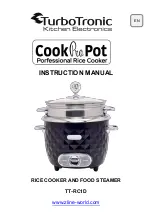
How it works
en
33
Poultry
¡
For duck or goose, pierce the skin on the underside
of the wings. This allows the fat to drain out.
¡
If using duck breast, score the skin. Do not turn
duck breasts.
¡
Poultry will turn out particularly crispy and brown if
you baste it towards the end of the roasting time
with butter, salted water or orange juice.
Meat
¡
Coat lean meat with fat as required, or separate the
pieces.
¡
When roasting, add a little liquid if the meat is lean.
Cover the base of the glass cookware with ap-
prox. 1/2 cm of liquid.
¡
Score the rind crosswise. If you turn the joint when
cooking it, ensure that the rind is underneath to be-
gin with.
¡
When the joint is ready, turn off the oven and allow
it to rest for a further 10 minutes in the cooking
compartment, keeping the door closed. This helps
distribute the meat juices more evenly. Wrap the
joint in aluminium foil if necessary. The resting time
is not included in the specified cooking time.
¡
It is more convenient to roast and braise meat in the
cookware. You can take the joint out of the cooking
compartment more easily in the cookware, and pre-
pare the sauce in the cookware itself.
¡
The quantity of liquid depends on the type of meat,
the material the cookware is made from and on
whether or not a lid is used. If you are cooking meat
in an enamelled or dark-coloured metal roasting
dish, it will need a little more liquid than if cooked in
glass cookware.
¡
The liquid in the cookware evaporates as the meat
roasts. Carefully pour in more hot liquid if required.
¡
The distance between the meat and the lid must be
at least 3 cm. The meat may expand.
¡
To braise the meat, sear it first as required. Add wa-
ter, wine, vinegar or similar for the braising liquid.
The base of the cookware must be covered with 1–
2 cm of liquid.
Fish
¡
You do not need to turn whole fish.
¡
Place the whole fish into the cooking compartment
in swimming position with the dorsal fin facing up-
wards.
¡
Placing half a potato or a small ovenproof container
in the stomach cavity of the fish provides stability.
¡
You can tell when the fish is cooked because the
dorsal fin can be removed easily.
¡
When stewing, add two to three tablespoons of li-
quid and a little lemon juice or vinegar into the
cookware.
Tips for roasting and braising
Use these tips for good results when roasting and
braising.
Topic
Tip
Lean meat must not dry
out.
¡
Coat lean meat with fat
or oil as required or
cover it with strips of
bacon.
If you want to cook a joint
with rind, proceed as fol-
lows:
¡
Score the rind in a
criss-cross pattern.
¡
Roast the joint with the
rind facing down first.
Keep the cooking com-
partment as clean as pos-
sible.
¡
Cook the food in a
covered roasting dish
at a higher temperat-
ure.
Or:
¡
Use the grill tray. If re-
quired, the grill tray
can be bought later as
an optional accessory.
You want the meat (e.g.
roast beef) to remain hot
and succulent.
¡
When the roast is
ready, switch off the
oven and leave the
meat to rest for
10 minutes in the
cooking compartment
with the door closed.
This helps distribute
the meat juices more
evenly. The resting
time is not included in
the specified cooking
time.
¡
After preparing it, wrap
the food in aluminium
foil.
Recommended settings
Poultry
Food
Accessories/cook-
ware
Shelf posi-
tion
Type of
heating
Temperature
in °C/grill
setting
Cooking
time in mins
Chicken, 1.3 kg, unstuffed
Cookware without lid
2
200–220
60–70
Small chicken portions, 250 g each
Cookware without lid
3
220–230
30–35
Chicken goujons, nuggets, frozen
Universal pan
3
190–210
20–25
Duck, unstuffed, 2 kg
Cookware without lid
2
190–210
100–110
Duck breast, 300 g each, medium
Cookware without lid
3
240–260
30–40
Goose, unstuffed, 3 kg
Cookware without lid
2
170–190
120–140
Goose legs, 350 g each
Cookware without lid
3
220–240
40–50








































